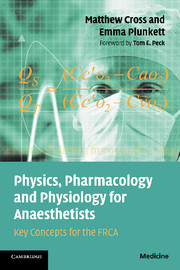Book contents
- Frontmatter
- Contents
- Acknowledgements
- Preface
- Foreword
- Introduction
- Section 1 Mathematical principles
- Mathematical relationships
- Exponential relationships and logarithms
- Physical measurement and calibration
- The SI units
- Section 2 Physical principles
- Section 3 Pharmacological principles
- Section 4 Pharmacodynamics
- Section 5 Pharmacokinetics
- Section 6 Respiratory physiology
- Section 7 Cardiovascular physiology
- Section 8 Renal physiology
- Section 9 Neurophysiology
- Section 10 Statistical principles
- Appendix
- Index
Physical measurement and calibration
Published online by Cambridge University Press: 15 January 2010
- Frontmatter
- Contents
- Acknowledgements
- Preface
- Foreword
- Introduction
- Section 1 Mathematical principles
- Mathematical relationships
- Exponential relationships and logarithms
- Physical measurement and calibration
- The SI units
- Section 2 Physical principles
- Section 3 Pharmacological principles
- Section 4 Pharmacodynamics
- Section 5 Pharmacokinetics
- Section 6 Respiratory physiology
- Section 7 Cardiovascular physiology
- Section 8 Renal physiology
- Section 9 Neurophysiology
- Section 10 Statistical principles
- Appendix
- Index
Summary
This topic tests your understanding of the ways in which a measurement device may not accurately reflect the actual physiological situation.
Accuracy
The ability of a measurement device to match the actual value of the quantity being measured.
Precision
The reproducibility of repeated measurements and a measure of their likely spread.
In the analogy of firing arrows at a target, the accuracy would represent how close the arrow was to the bullseye, whereas the precision would be a measure of how tightly packed together a cluster of arrows were once they had all been fired.
Drift
A fixed deviation from the true value at all points in the measured range.
Hysteresis
The phenomenon by which a measurement varies from the input value by different degrees depending on whether the input variable is increasing or decreasing in magnitude at that moment in time.
Non-linearity
The absence of a true linear relationship between the input value and the measured value.
Zeroing and calibration
Zeroing a display removes any fixed drift and allows the accuracy of the measuring system to be improved. If all points are offset by ‘+ x’, zeroing simply subtracts ‘x’ from all the display values to bring them back to the input value. Calibration is used to check for linearity over a given range by taking known set points and checking that they all display a measured value that lies on the ideal straight line.
- Type
- Chapter
- Information
- Physics, Pharmacology and Physiology for AnaesthetistsKey Concepts for the FRCA, pp. 14 - 17Publisher: Cambridge University PressPrint publication year: 2008



